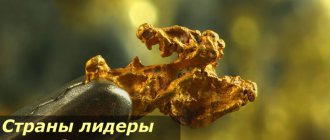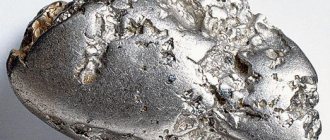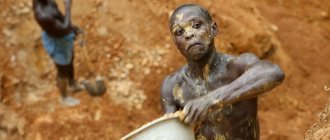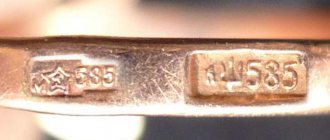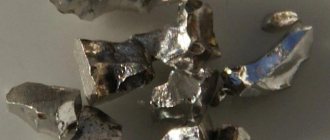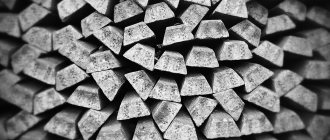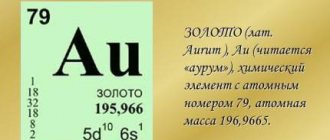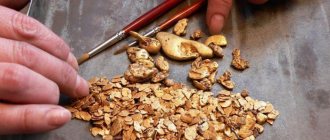According to most scientists, humanity has been studying and mining gold for 6 thousand years. Typically, this precious metal was used in gold coins. They first appeared in 550 BC in the Mediterranean state of Lydia. Nowadays this resource is one of the most popular. Having studied the opinions of experts, we can draw a conclusion about how much gold there is in the world.
World reserve estimates
To roughly determine how many tons of gold there are in the world, one can imagine that the entire volume of the metal in question, which humanity has mined over the entire period of its existence, was melted down into one figure. It will be able to take the form of a huge cube. The length of each edge will be about 20 meters.
However, the reality is that the precious resource is scattered in small pieces throughout the world. In this regard, it is impossible to say exactly how much gold has been mined and where it is located. But you can use information that is provided by specialized media. Then it will be possible to make a rating of the regions where the most gold is stored and mined.
There is an organization that carries out a thorough analysis of the global market for gold reserves. It's called Thomson Reuters GFMS . According to its representatives, the reserves of the metal in question on Earth are about 172 thousand tons.
However, there are other opinions on this matter. Some experts believe that there may be from 155 thousand to 2.5 million tons of gold on Earth. This error is due to the fact that usage was not recorded at all times, and a lot of information was contained in state or personal secrets.
According to James Turk, one of the researchers of the history of the precious metal, by 1500 AD, humanity had mined no more than 15 thousand tons of gold. He attributes this to the fact that at that time the study and mining of gold were quite complex undertakings. The technologies of that time made it possible to obtain a small volume of metal with large time and resource costs.
And Jen Skoyles, an employee of The Real Asset Company, believes that this figure could be up to 300 thousand tons. According to his research, approximately 1,500 kilograms of gold were spent to make Tutankhamun’s coffin alone. As is known, in ancient times, many robbers robbed such burials, appropriating large volumes of gold. Skoyles believes that most of the jewelry was not studied by archaeologists because it was not found.
An interesting fact is that gold, which was once mined from the depths of the earth, has not disappeared anywhere and continues to be used in circulation. Thus, when purchasing any piece of jewelry, there is a chance that gold that was mined centuries earlier was used to make it.
The current volumes of world gold reserves are also difficult to estimate. Most experts believe that official information on this matter is incorrect and the real figures are much higher. Many associate this with conspiracy theories, but the point is in the accounting procedure itself. It is believed that an impressive portion of the world's reserves are not calculated because they are kept secret. For example, no one knows exactly how much gold is mined in China or how much precious metals are “walking” on the black market in Colombia.
Despite this, all scientists are confident that the world's reserves of the precious metal will not be depleted for a long time and humanity will not experience serious problems with this.
Types of gold deposits
Depending on the process of formation and localization, primary (root) deposits are divided into secondary (placer) deposits. Let's talk about this division in more detail.
Bedrock deposits
Such deposits are a consequence of the movement of magma during an era of volcanic activity. The gold content in the magmatic fluid is much higher than in the layer of the earth's crust.
Breaking out, the magma began to gradually cool, which started the process of mineral formation. Elements with a high refractoriness index crystallized first, however, low-melting substances continued to move inside the resulting tunnel. Gold is not the only element with a low melting threshold; the mass was a complex complex of chemical compounds. That is why in the area of primary deposits gold is rarely found in its pure form. More often than other compounds where precious metal is present, minerals and ores containing iron, copper, lead and zinc are found.
The magma moved and solidified unevenly; through cracks and faults in the dense rock, the liquid part broke through into the upper layers of the crust. This is how bedrock deposits were formed, having the character of veins and stockworks, including the largest gold deposits of world significance. Since mountains are the result of volcanic activity, it is advisable to look for primary gold reserves in mountainous areas.
Placers
Secondary gold reserves arose as a result of long-term mechanical and chemical impact on primary deposits. Groundwater, wind, rock collapse and other factors contributed to the movement of gold particles from the mountains to the flat area.
The main contribution to the emergence of placer deposits belongs to water: rains and mountain rivers carried pieces of rock down to the mountain foothills. Colliding with the boulders and each other, the igneous rock was crushed, releasing grains of gold. And since it is inert in relation to other chemical elements, the particles settled in their pure form in the depressions of the river bottom.
Despite the common source of formation, there may be a large distance between bedrock and placer reserves. Since the earth's surface has changed many times over the millions of years of its existence, it is not always possible to track the migration of gold from the primary mine.
Placer deposits are smaller than primary ones, but they are easier to develop, since they lie on the surface, and gold does not require an extraction procedure.
You may be interested in: How is gold mined? Methods and methods of extraction
Rating of countries by resource volumes
It is impossible to say with 100% certainty where the most gold is in the world today. In some countries, indicators are a state secret, and it is also impossible to calculate the volume of black markets. However, there are estimates that help bring clarity to the overall picture.
In 2021, 5 states can be distinguished whose political goals pay special attention to the extraction of precious minerals. Their list is as follows:
- China. Serious gold mining activities began in this state in 2007. Since then, the country has occupied a leading position in the market and has produced a significant amount of the total reserves on Earth. The exact number of minerals, as well as the place of their extraction, is a secret. According to expert estimates, about 300 tons of gold are mined here per year;
- Republic of South Africa. The lands of this small state are quite rich in minerals. Scientists believe that more than 15% of the world gold mining market belongs to this country. Approximately 250 tons per year are mined here.
- Australia. In the western part of this state there are significant facilities that produce impressive volumes of precious metal per year. This figure here is 225 tons.
- USA. The leading state in terms of gold production is Nevada. Approximately ¾ of the country's reserves are located here. In second place in terms of this indicator is Alaska, which brings the United States approximately 30 tons per year. In terms of technology, this country is the undisputed leader in the field of gold mining. In recent years, progressive geological research has been carried out in the country, during which many new gold deposits were discovered. It is not known exactly how many resources are mined in the United States. However, many researchers consider this country to be the world leader in reserves of “solar” metal.
- Peru. Every year this country extracts about 175 tons of this type of metal from the bowels of the earth.
This is an average rating, which is obtained from the opinions of many respected publications. Each publishes its own research, which may differ. The error is associated with various sources, with constant jumps in indicators within the countries themselves, and much more.
Production growth and decline trends
In 2015, the amount of gold mined annually in the world rose to an all-time high. This year the figure increased by 1.8 percent and amounted to 3,211 tons per year. Thus, there is a constant increase in both the volume of gold in storage and the volume of its production in the world.
It is worth noting that this is happening thanks to developing countries that are establishing a gold mining system on their territory. Over the past few years, the following countries have increased the amount of minerals they produce:
- Kazakhstan - by 29 percent;
- Indonesia - by 20 percent;
- Mexico - by 18 percent.
The richest deposit in the world is considered to be the Muruntau quarry, which is located on the territory of Kazakhstan. Experts disagree, but they are confident that from 2,500 to 5,300 tons of precious metal can be extracted from these deposits. In addition, this is the largest open pit mine in the world, with a depth of 580 meters.
There are other trends that are taking place in the precious metals market. For example, the aforementioned jump in production in China that occurred in 2007. In the shortest possible time, the state was able to overtake South Africa, which was considered a world leader over the past 100 years. Moreover, there was not only an increase in production in China, but also a decline in South Africa.
"Solar" metal in Russia
Most authoritative publications that publish ratings of gold mining countries place the Russian Federation in 6th place. However, the majority of the market is alluvial gold. Russia ranks 1st in the world for this type of metal.
Placer gold is a collection of loose particles formed during the processing and destruction of bedrock and minerals that are found in the earth in high concentrations. Such deposits operate on a different principle than the standard one . Vivid examples of such places:
- Khatynakh-Sala in Sakha-Yakutia;
- Bolsheshaldinskaya in the Urals;
- Moss swamp in the Urals.
However, we should not forget that an impressive part of the total volume of gold comes from primary deposits, where standard mining methods are used.
Obviously, the most significant objects are located in Siberia and the Far East. The vast majority of all gold mined in the state comes from here. Since 2007, in each calculation period, the volume of production in the Russian Federation has been systematically increasing.
Over the past 10 years, this figure in Russia is approximately 300 tons per year. Of these, approximately 200-230 thousand kilograms are mined in deposits, and the rest is obtained after processing the ore of some non-ferrous metals, as well as processing secondary raw materials.
The main advantage of mining in Russia is that the resources are located quite close to the surface of the earth than in other countries. List of the most significant objects in the Russian Federation:
- Khakanja in the Far East;
- pyrite-polymetallic deposits in Altai;
- gold-bearing skarns at the junction of the Minusinsk Basin and the Eastern Sayan;
- Kuranahanskoye field in Sakha-Yakutia;
- magmatic copper-nickel springs in the Krasnoyarsk region.
Although it is quite difficult to calculate the exact amount of the world's gold reserves on Earth due to a lot of hidden information, one thing can be said with complete confidence: the volume of the precious metal that is stored on our planet is so large that it will last for many generations to come.
When will there be a shortage?
Experts give different estimates on the size of precious metal deposits that exist on the planet today. The fact is that only those deposits that are currently operating are considered; their reserves are estimated approximately. When predicting a particular outcome, experts often disagree. Some say that gold will last for 20 years, while others claim that for II
–
In the 3rd century
, humanity will not know what a deficiency of the yellow metal is.
Our planet is rich in various elements and most of them are not found on the surface of the earth, but in its depths. Au was no exception; the 79th element of D.I. Mendeleev’s table is hidden from human eyes under tons of rock.
Geologists unanimously claim that deposits of the precious metal are located deep in the earth, they are in close proximity to the core of the planet. From an economic point of view, developing such deposits is unprofitable. But the situation may change radically.
All skeptics should cite the example of the Soviet Union, on whose territory they searched for and developed only alluvial deposits, and did not develop indigenous ones at all. The reason for this was the reluctance of the authorities to develop the industry and spend money on equipment and specialists.
But sooner or later there will be a shortage, and then what? Today, scientists have three options for the development of events:
- Mining precious metals from space.
- Recycle recyclable materials.
- Filter the water of the seas and oceans.
How much gold is mined and how much remains in the bowels of the earth does not matter, since it all came to us from space. Au came to Earth from the space of the Universe. And there is a chance to mine the precious metal on the territory of not only our planet, but also other celestial bodies. For example, quartz deposits were recently discovered on Mars, and quartz is the main satellite of gold.
Already today, the recycling industry is thriving, with citizens taking broken jewelry to pawn shops. They are melted down and new, very beautiful products are made from the resulting material.
Au is present in sea water; this discovery did not strike the world only because experts have not yet found a single method that would allow extracting the element from the depths of the seas and oceans. Today, experts are working on the problem of extracting Au from water and are ready to offer a new, alternative extraction method using bacteria that combine precious metal ions.
And about 10-11% of gold is destroyed during storage, subject to mechanical damage and one way or another ends up in nature again.
